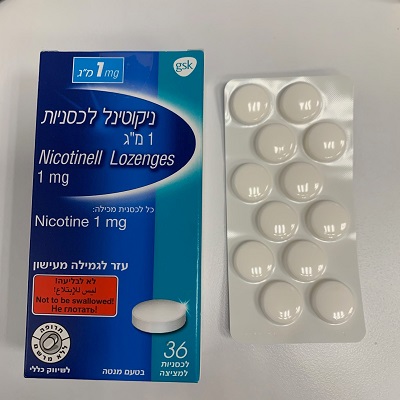Quest for the right Drug

ניקוטינל לכסניות 1 מ"ג NICOTINELL LOZENGES 1 MG (NICOTINE)
תרופה במרשם
תרופה בסל
נרקוטיקה
ציטוטוקסיקה
צורת מתן:
פומי : PER OS
צורת מינון:
לכסניה : LOZENGES
עלון לרופא
מינוניםPosology התוויות
Indications תופעות לוואי
Adverse reactions התוויות נגד
Contraindications אינטראקציות
Interactions מינון יתר
Overdose הריון/הנקה
Pregnancy & Lactation אוכלוסיות מיוחדות
Special populations תכונות פרמקולוגיות
Pharmacological properties מידע רוקחי
Pharmaceutical particulars אזהרת שימוש
Special Warning עלון לרופא
Physicians Leaflet
Adverse reactions : תופעות לוואי
4.8 Undesirable effects Nicotinell lozenges can cause adverse reactions similar to those associated with nicotine administered by smoking.These can be attributed to the pharmacological effects of nicotine, which are dose- dependent. Non dose-dependent adverse reactions are as follows: hypersensitivity, angioneurotic oedema and anaphylactic reactions. Most of the adverse reactions which are reported by patients occur generally during the first 3-4 weeks after initiation of therapy. Nicotine from lozenges may sometimes cause a slight irritation of the throat and increased salivation at the start of the treatment. Excessive swallowing of nicotine which is released in the saliva may, at first, cause hiccups. Those who are prone to indigestion may suffer initially from minor degrees of dyspepsia or heartburn; slower sucking will usually overcome this problem. Excessive consumption of lozenges by subjects who have not been in the habit of inhaling tobacco smoke, could possibly lead to nausea, faintness and headache. Increased frequency of aphthous ulcer may occur after abstinence from smoking. Adverse reactions are listed below, by system organ class and frequency. Frequencies are defined as: very common (≥1/10), common (≥1/100 to <1/10), uncommon (≥1/1,000 to <1/100), rare (≥1/10,000, <1/1,000) or very rare (<1/10,000). The following adverse reactions which were identified from a double-blind, randomisedf, placebo- controlled lozenge clinical study involving 1818 patients. Adverse events reported in this study have been considered for inclusion, ehere the incidence in the 2 mg and 4 mg nicotine arm higher than the corresponding placebo arm. Frequiencies are calculated from safety data of the study. Nervous system disorders: Common: dizziness*, headache* Gastrointestinal disorders: Very common: nausea Common:, Hiccups, gastritis symptoms e.g. flatulence, vomiting, stomatitis, oral discomfort, abdominal pain, upper diarrhea, dry mouth, constipation Cardiac disorders: Uncommon: palpitations Rare: atrial arrhythmia (e.g. atrial fibrillation) Immune system disorders: Rare: hypersensitivity, angioneurotic oedema and anaphylactic reactions. Psychiatric disorders: Common: Insomnia* Respiratory, thoracic and mediastinal disorders: Common: pharyngitis, cough*, pharyngolaryngeal pain. * These events may also be due to withdrawal symptoms following smoking cessation. Post marketing data: The following adverse reactions which were identified from a post marketing experience of nicotine oral forms. As these reactions are reported voluntarily from a population of uncertain size, the frequency of these reactions is unknown. Immune system disorders: Hypersensitivity, angioedema, urticaria, ulcerative stomatitis, and very rare anaphylactic reactions. Nervous system disorders: Tremor Cardiac disorders: Palpitations, tachycardia, arrhythmias. Respiratory, thoracic and mediastinal disorders: Dyspnoea Gastrointestinal disorders: Dysphagia, eructation, salivary hypersecretion General disorders and administration site conditions: Asthenia**, Fatigue**, malaise**, influenza type illness** ** These events may also be due to withdrawal symptoms following smoking cessation. Certain symptoms which have been reported such as dizziness, headache and insomnia may be ascribed to withdrawal symptoms in connection with smoking cessation and may be due to insufficient administration of nicotine. Cold sores may develop in connection with smoking cessation, but any relation with the nicotine treatment is unclear. The patient may still experience nicotine dependence after smoking cessation. Reporting of suspected adverse reactions Reporting suspected adverse reactions after authorisation of the medicinal product is important. It allows continued monitoring of the benefit/risk balance of the medicinal product. Any suspected adverse events should be reported to the Ministry of Health according to the National Regulation by using an online form. https://forms.gov.il/globaldata/getsequence/getsequence.aspx?formType=AdversEffectMedic@moh.g ov.il

פרטי מסגרת הכללה בסל
התרופה האמורה תינתן לטיפול גמילה מעישון הניתן במקביל לליווי באמצעים תומכים או במקביל להתערבות תמיכתית מלווה
מסגרת הכללה בסל
התוויות הכלולות במסגרת הסל
| התוויה | תאריך הכללה | תחום קליני | Class Effect | מצב מחלה |
|---|---|---|---|---|
| טיפול גמילה מעישון הניתן במקביל לליווי באמצעים תומכים או במקביל להתערבות תמיכתית מלווה | 16/01/2019 | התמכרויות | גמילה מעישון | |
| לטיפול גמילה מעישון לחולים המשתתפים בסדנה לגמילה מעישון המבוצעת על ידי קופות החולים או מטעמן, או שהשלימו השתתפות בסדנה זו; (עבור נגמלים שאינם יכולים להשתמש ב-Buprenorphine או Varenicline על רקע אזהרות או הוריות נגד) | 15/01/2015 | התמכרויות | גמילה מעישון | |
| לטיפול גמילה מעישון (מחיר מלא) | 01/01/1995 | התמכרויות | גמילה מעישון |
שימוש לפי פנקס קופ''ח כללית 1994
Aid to smoking cessation
תאריך הכללה מקורי בסל
01/01/1995
הגבלות
תרופה שאושרה לשימוש כללי בקופ'חתרופה מוגבלת לרישום ע'י רופא מומחה או הגבלה אחרת
מידע נוסף
